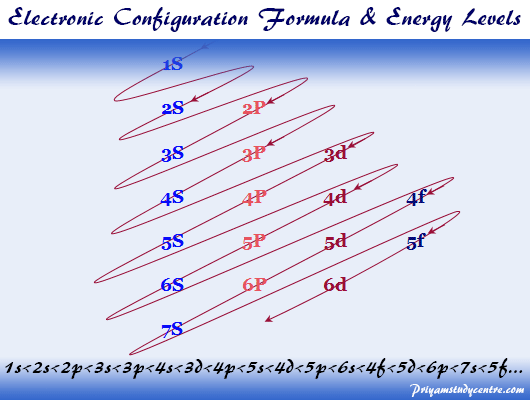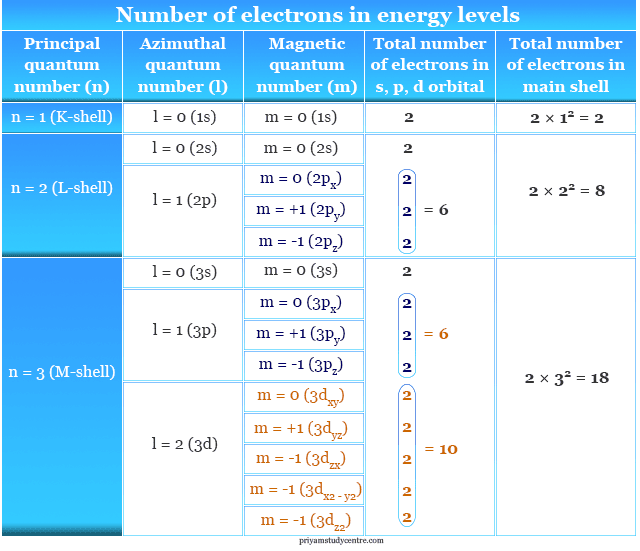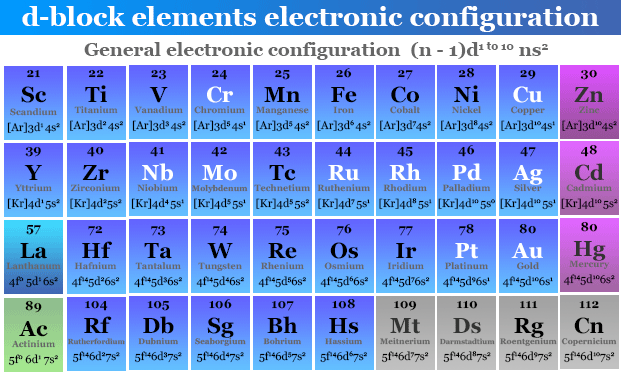General Electronic Configuration of Group 18 Elements
Electronic configuration of elements in periodic table
Electronic configuration or general electron configuration or electronic structure of atoms or ions is the arrangement of orbital energy levels for s, p, d, and f-block elements of the periodic table. In chemistry or chemical science, electron holds the key to the chemical world for learning properties and position of elements in the periodic table. Electronic configuration or electron arrangement formula of the periodic table elements is used for better understanding the chemical properties like oxidizing reducing properties, oxidation number, ionization energy, electron affinity, shielding effect, the polarity of chemical bonds, acids bases properties, etc.
A reaction to reach chemical equilibrium is the change of electron configuration of reactant and product atoms. Hence the organic and inorganic chemical reactions are better understood by the electronic configuration of elements.
How to find electronic configuration?
To find the electron configuration formula first we find the order of electronic energy levels of s, p, d, and f orbitals or sub-levels. For example, 3s orbital has lower energy than 3p orbitals which again lower energy than the 3d level. The modern periodic table classification like s, p, d, and f block elements is based on properties and general electron or electronic configuration of elements.
What are electron energy levels?
Energy levels are fixed distances where electrons are rotating around the nucleus with definite energy. The energy associated with a certain energy level increases with the increase of its distance from the nucleus. The hydrogen atom contains only one electron in 1s hydrogen energy levels with electronic configuration 1s1. But difficult for readers to remember the electron energy levels diagram for many electronic configurations. Therefore, the trivial way but most convenient way to remember these electronic energy levels is given below the diagram.

- The different electron orbitals originating from the same electronic energy levels are written in horizontal lines.
- Now inclined parallel lines are drawn through the electronic orbitals according to the above picture.
- Filling up the different orbitals by the number of electrons will follow these lines configuration. According to above diagram structure, configuration energy levels with electron constructed the following ordering, 1s < 2s < 2p < 3s < 3p < 4s < 3d < 4p < 5s < 4d < 5p < 6s < 4f < 5d < 6p < 7s < 5f…
Number of electrons in energy levels
The filling up electronic orbitals with electrons around the nucleus of atoms takes place according to certain rules. The maximum number of electrons in the main energy levels = 2n2, where n = principal quantum number. The maximum number of the electron in sub-shell like s, p, d, and f orbitals = 2(2l + 1). Where l = 0, 1, 2, 3 for s, p, d, f orbitals. Therefore, s, p, d, f energy levels have a maximum of 2, 6, 10, 14 electrons respectively.

Aufbau principle and electron configuration
German scientist Aufbau expresses the building up principle for the electron configuration process in different electronic orbitals of atoms. Hence according to this principle, the electrons are filled up in order of energy. The orbitals with the lowest energy filled up first while the highest energy orbital filled up in the end. The electron will tend to form maximum spin. Electrons with similar spin are configuration first.
What is Hund's rule?
According to Hund's rule, electrons are filling in the orbital with maximum spin multiplicity. Spin pairing occurs only when vacant orbitals of similar energy are not available for occupation.
Electronic configuration and periodic table
The electronic configuration formula uses to derive some basic properties like the electromagnetic spectrum, chemical bonding, electric polarization, dipole moment, hydrogen bonding, etc. Modern periodic table classified on the basis of chemical behavior and electronic configuration of elements. Hence the electron configuration formula of elements must be connected with the periodic table. According to electronic configuration, the periodic table elements are classified into four blocks like s, p, d, f-block elements.
Electronic configuration of s block elements
For s-block elements, the electron enters the ns-orbitals and progressively filled with atomic number. Group-1 and 2 belong to s-block elements in the periodic table with general electron configuration ns1→2, where n = number of electronic shells or the number of periods in which the element present.
Electronic configuration of group-1 elements
Group-1 or IA in the periodic table contains seven elements like hydrogen, lithium, sodium, potassium, rubidium, cesium, and francium with the general electronic configuration of valence electron = ns1, where n = 1 to 7. Due to the presence of one electron in the outer electronic structure, they have very low ionization energy but very high electron affinity.
| Atomic number | Name of elements | Electronic configuration |
| 1 | Hydrogen (H) | 1s1 |
| 3 | Lithium (Li) | 1s2 2s1 |
| 11 | Sodium (Na) | [Ne] 3s1 |
| 19 | Potassium (K) | [Ar] 4s1 |
| 37 | Rubidium (Rb) | [Kr] 5s1 |
| 55 | Cesium (Cs) | [Xe] 6s1 |
| 87 | Francium (Fr) | [Rn] 7s1 |
Electronic configuration of group-2 elements
The elements of Group-2 or IIA in the periodic table are beryllium, magnesium, calcium, strontium, barium, and radium. They also called alkaline earth metals. The valence shell electronic configuration of group-2 elements or alkaline earth metals is = ns2, where n = 1 to 6.
| Atomic Number | Name of elements | Electronic configuration |
| 4 | Beryllium (Be) | 1s2 2s2 |
| 12 | Magnesium (Mg) | [Ne] 3s2 |
| 20 | Calcium (Ca) | [Ar] 4s2 |
| 38 | Strontium (Sr) | [Kr] 5s2 |
| 56 | Barium (Ba) | [Xe] 6s2 |
| 88 | Radium (Ra) | [Rn] 7s2 |
Electronic configuration of p block elements
The elements in which the p-orbital are progressively filled by electrons are called p-block in the periodic table. Helium whose electronic configuration 1s2 but Helium is a member of p-block elements. p-block contains six groups from group-13 to group-18. The general electronic configuration formula to find the outer electron configuration of the p-block element is ns2 np1→6.
Electronic configuration of group-13 elements
Group-13 or IIIA contains five elements, boron, aluminum, gallium, indium, thallium. The valence shell electron configuration of group-13 elements is ns2 np1.
| Atomic number | Name of elements | Electronic configuration |
| 5 | Boron (B) | 1s2 2s2 2p1 |
| 13 | Aluminum (Al) | [Ne] 3s2 3p1 |
| 31 | Galium (Ga) | [Ar] 3d10 4s2 4p1 |
| 49 | Indium (In) | [Kr] 4d10 5s2 5p1 |
| 81 | Thallium (Tl) | [Xe] 4f14 5d10 6s2 6p1 |
Electronic configuration of group-14 elements
Carbon, silicon, germanium, tin, and lead in the periodic table belong to group-14 or IVA. The general electronic configuration of group-14 elements is ns2 np2, where n = 2 to 6.
| Atomic number | Name of elements | Electronic configuration |
| 6 | Carbon (C) | 1s2 2s2 2p2 |
| 14 | Silicon (Si) | [Ne] 3s2 3p2 |
| 32 | Germanium (Ge) | [Ar] 3d10 4s2 4p2 |
| 50 | Tin (Sn) | [Kr] 4d10 5s2 5p2 |
| 82 | Lead (Pb) | [Xe] 4f14 5d10 6s2 6p2 |
Electronic configuration of group-15 elements
The five elements of Group-15 or VA are nitrogen, phosphorus, arsenic, antimony, bismuth. The electronic configuration of group-15 elements is ns2 np3, where n = 2 to 6.
| Atomic number | Name of elements | Electronic configuration |
| 7 | Nitrogen (N) | 1s2 2s2 2p3 |
| 15 | Phosphorus (P) | [Ne] 3s2 3p3 |
| 33 | Arsenic (As) | [Ar] 3d10 4s2 4p3 |
| 51 | Antimony (Sb) | [Kr] 4d10 5s2 5p3 |
| 83 | Bismuth (Bi) | [Xe] 4f14 5d10 6s2 6p3 |
Electronic configuration of group-16 elements
Oxygen, sulfur, selenium, tellurium, and polonium in the periodic table belong to group-16 or VIA. The general electronic configuration of group-16 elements is ns2 np4, where n = 2 to 6.
| Atomic number | Name of elements | Electronic configuration |
| 8 | Oxygen (O) | 1s2 2s2 2p4 |
| 16 | Sulfur (S) | [Ne] 3s2 3p4 |
| 34 | Selenium (Se) | [Ar] 3d10 4s2 4p4 |
| 52 | Tellurium (Te) | [Kr] 4d10 5s2 5p4 |
| 84 | Polonium (Po) | [Xe] 4f14 5d10 6s2 6p4 |
Electronic configuration of group-17 elements
Fluorine, chlorine, bromine, iodine, astatine in the periodic table belong to group-17 or VIIA. The general electronic configuration of group-17 elements is ns2 np5, where n = 2 to 6.
| Atomic number | Name of elements | Electronic configuration |
| 9 | Fluorine (F) | 1s2 2s2 2p5 |
| 17 | Chlorine (Cl) | [Ne] 3s2 3p5 |
| 35 | Bromine (Br) | [Ar] 3d10 4s2 4p5 |
| 53 | Iodine (I) | [Kr] 4d10 5s2 5p5 |
| 85 | Astatine (At) | [Xe] 4f14 5d10 6s2 6p5 |
Electronic configuration of noble gases
Neon, argon, krypton, xenon, radon in the periodic table belong to group-18 or noble gases. The general electronic configuration of noble gases or group-18 elements is ns2 np6, where n = 1 to 6.
| Atomic Number | Name of Elements | Electronic configuration |
| 2 | Helium (He) | 1s2 |
| 10 | Neon (Ne) | 1s2 2s2 2p6 |
| 18 | Argon (Ar) | [Ne] 3s2 3p6 |
| 36 | Krypton (Kr) | [Ar] 3d10 4s2 4p6 |
| 54 | Xenon (Xe) | [Kr] 4d10 5s2 5p6 |
| 86 | Radon (Rn) | [Xe] 4f14 5d10 6s2 6p6 |
Electronic configuration of d block elements
The elements in which the electron enters in (n -1)d orbital are called d-block elements. These are placed in the middle of the periodic table, between s and p-block elements due to their chemical behavior like boing point, melting by specific heat, density, ionization energy, bonding, etc. The general electronic configuration of valence electron of 3d, 4d, 5d, 6d elements represented as ns0,1,2 (n-1)d1→10. These elements are called transition metals or elements. The names, symbols, and valence shell electronic configuration of all the d-block elements or transition metals are given below the picture,

Electronic configuration of first transition series
The first crystalline solid metal in the 3d-series or first transition series starts with scandium and ending with zinc. When the twenty-first electron goes to the next available higher energy 3d orbital, the five 3d subshells filling by ten electrons.
The general electronic configuration of valence electron of 3d series or first transition series like scandium, titanium, vanadium, chromium, manganese, iron, cobalt, nickel, copper, and zinc is [Ar] 4S1→2 3d1→10.
| Atomic number | Name of elements | Electronic configuration |
| 21 | Scandium (Sc) | [Ar] 4s2 3d1 |
| 22 | Titanium (Ti) | [Ar] 4s2 3d2 |
| 23 | Vanadium (V) | [Ar] 4s2 3d3 |
| 24 | Chromium (Cr) | [Ar] 4s1 3d5 |
| 25 | Manganese (Mn) | [Ar] 4s2 3d5 |
| 26 | Iron (Fe) | [Ar] 4s2 3d6 |
| 27 | Cobalt (Co) | [Ar] 4s2 3d7 |
| 28 | Nickel (Ni) | [Ar] 4s2 3d8 |
| 29 | Copper (Cu) | [Ar] 4s1 3d10 |
| 30 | Zinc (Zn) | [Ar] 4s1 3d10 |
Exceptional electron configuration
In learning chemistry, chromium, and copper, the 3d elements of our environment reveal their general form of electron or electronic configuration trends in the periodic table. Hence the general electronic configuration valence electron of chromium and copper are [Ar]4s2 3d4 and [Ar] 4s2 3d9. In the periodic table elements, the half-filled and filled orbitals electron configuration formula is relatively more stable than the partially filled orbitals. Thus 3d orbital of chromium and copper recording to form new electronic configuration like [Ar]4s1 3d5 and [Ar] 4s1 3d10 to gain extra chemical stability by exchange energy.
General Electronic Configuration of Group 18 Elements
Source: https://www.priyamstudycentre.com/2019/01/electron-configuration.html

0 Response to "General Electronic Configuration of Group 18 Elements"
Post a Comment